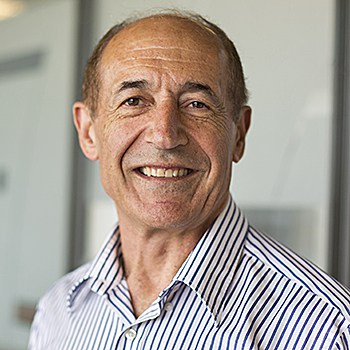Location
2800 Plymouth Road, Ann Arbor, MI 48109-2800
Phone
Primary Website
Additional Title(s)
- Donald L. Katz Collegiate Professor
Education
- PhD, California Institute of Technology (1973), Chemical Engineering
- BS, Robert’s College (1969), Chemical Engineering
Experience
University of Michigan
Chemical Engineering Department
Ann Arbor, Michigan
Donald L. Katz Collegiate Chair, Professor, 2003 – present
Professor, 1985 – present
Associate Professor, 1982 – 1985
Assistant Professor, 1978 – 1982
University of Michigan College of Engineering
Ann Arbor, Michigan
Associate Dean – Research and Graduate Education, 2009 - Senior Associate Dean, 1986 – 1993
Komili Inc.
Ayvalik, Turkey
Technical Manager, 1974 – 1976
Professional Service
- National Institutes of Health, SBIR study section, 2002 – present
- National Institutes of Health, software study section, 2004 – present
Research Interests
- Microfluidic MEMS devices
- DNA, peptide synthesis, and genetic diagnostics
- Micro reactors for fuel processors
- Environmental catalysis
Note from Professor Gulari
My group’s research is on reactions at interfaces and developing microfluidic MEMS devices for biosynthesis and genetic diagnosis.
Currently the largest effort in my group is devoted towards making “biochips” or DNA and peptide chips for gene expression, SNP detection and drug – protein interactions. We are into our third generation DNA chips and microfluidic reactor systems. Our patented technology allows massively parallel synthesis of DNA oligomers and peptides on silicon/glass and plastic chips. In terms of application, we are focusing on diagnostic applications in the area of water and food safety as well as medical diagnostics. For the future our focus will be slightly shifting towards massively parallel PCR based detection assays and to making combinatorial libraries of Si RNAs as well as synthetic genes. We collaborate extensively with colleagues at U-M and MSU.
Increased motor vehicle and electrical power usage demands continual improvement of air cleaning and hydrogen purification catalysts. We are developing and testing new supported catalysts by incorporating pre-synthesized metal crystallites in oxide supports by single step sol-gel processing. This method enables us to independently vary the metal crystallite size and the loading. So far this method has enabled us to make superior silver-, gold-, copper- and platinum-based catalysts. However, many challenges still remain in increasing the activity of the catalysts by a factor of almost ten and making them robust against poisoning and sintering. We have an ongoing collaboration in this area with colleagues from Ford Motor Co.
Awards
- Department of Chemical Engineering Outstanding Achievement Award, 2002
University of Michigan - College of Engineering, Excellence in Service Award, 1995
University of Michigan - Department of Chemical Engineering, Departmental Research Excellence Award, 1994
University of Michigan - Chemical Engineer of the Year Award, 1990
Detroit Chapter, American Institute of Chemical Engineering - ASEE AT&T Foundation Award (for Excellence as an Engineering Educator), 1989
American Society of Engineering Educators - Faculty Recognition Award (highest award given to U-M faculty), 1985-1986
University of Michigan - Excellence in Research Award, 1984
College of Engineering, University of Michigan - Featured as the Chemical Engineering Educator, Summer 1984
J. Chemical Engineering Education - Outstanding Teacher and Leadership Award, April 1981
Phi Lambda Upsilon Delta Chapter - Albert Long Hall Award, given to the graduating class valedictorian, 1969
Robert’s College - Fulbright Scholar, 1969 – 1974
- Earle C. Anthony Fellow, 1970-1971
California Institute of Technology
Publications
Selected Publications
- K. Lee, J. M. Rouillard 2, B. Kim, E. Gulari, and J. Kim, “ConjugatedPolymers Combined with a Molecular Beacon for Label-Free andSelf-Signal-Amplifying DNA Microarrays,” Advanced Functional Materials,19, 20, 3317 – 3325 Published Online: 2009.
- O. Srivannavit, M. Gulari, Z. Hua, X. Gao, X. Zhou, A. Hong, T.Zhou, and E. Gulari, “Microfluidic reactor array device for massivelyparallel in situ synthesis of oligonucleotide,” Sensors and ActuatorsB: Chemical, 140, 2, 16, 473-481, 2009.
- J. M. Rouillard and E. Gulari, “OligoArrayDb: pangenomic oligonucleotidemicroarray probe sets database,” Nucleic Acids Research,1–4,doi:10.1093/nar/gkn761, 2008.
- R. D. Stedtfeld, S. W. Baushke, D. M. Tourlousse, S. M. Miller, T. M.Stedtfeld, E. Gulari, J. M. Tiedje, and S. A. Hashsham, “Developmentand Experimental Validation of a Predictive Threshold Cycle Equationfor Quantification of Virulence and Marker Genes by High-ThroughputNanoliter-Volume PCR on the OpenArray Platform,” Applied andEnvironmental Microbiology, 74, 12, 3831-3838, 2008.
- W. Thitsartarn, E. Gulari , S. Wongkasemjit, “Synthesis of Fe-MCM-41from silatrane and FeCl3 via sol-gel process and its epoxidationactivity,” Applied Organometallic Chemistry, 22, 2, 97 – 103, PublishedOnline: 2008.
- S. Chavadeja, P. Phuaphromyoda, E. Gulari, P. Rangsunvigita and T.Sreethawong, “Photocatalytic degradation of 2-propanol by using Pt/TiO2prepared by microemulsion technique,” Chemical Engineering Journal,137, 3, 489, 2008.
- K. Lee, K. Maisel, J.M. Rouillard, E. Gulari, and J. Kim*,”Sensitive andSelective Label-Free DNA Detection by Conjugated Polymer-BasedMicroarrays and Intercalating Dye,” Chem. Mater., 20, 2848 – 2850, 2008.
- S.M. Miller, D.M. Tourlousse, R.D. Stedtfeld, S.W. Baushke, A.B.Herzog, L.M. Wick, J.M. Rouillard, E. Gulari, J.M. Tiedje, and S.A.Hashsham, “In situ-synthesized virulence and marker gene biochip fordetection of bacterial pathogens in water,” Applied and EnvironmentalMicrobiology, 74, 70099-2240/08/$08.00+0, 2200-2209,doi:10.1128/AEM.01962-07, 2008.
- Z. Hua, R. Pal, M. Burns and E. Gulari, “A Light Writable Microfluidic “Flash Memory”: optically addressed actuator array with latched operation for microfluidic applications,”, Lab. Chip., 8, 488-491, 2008.
